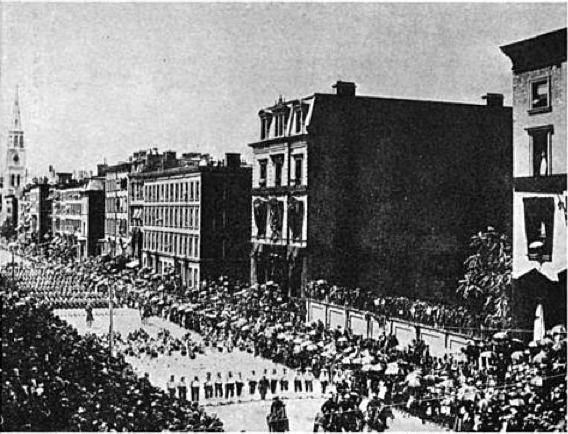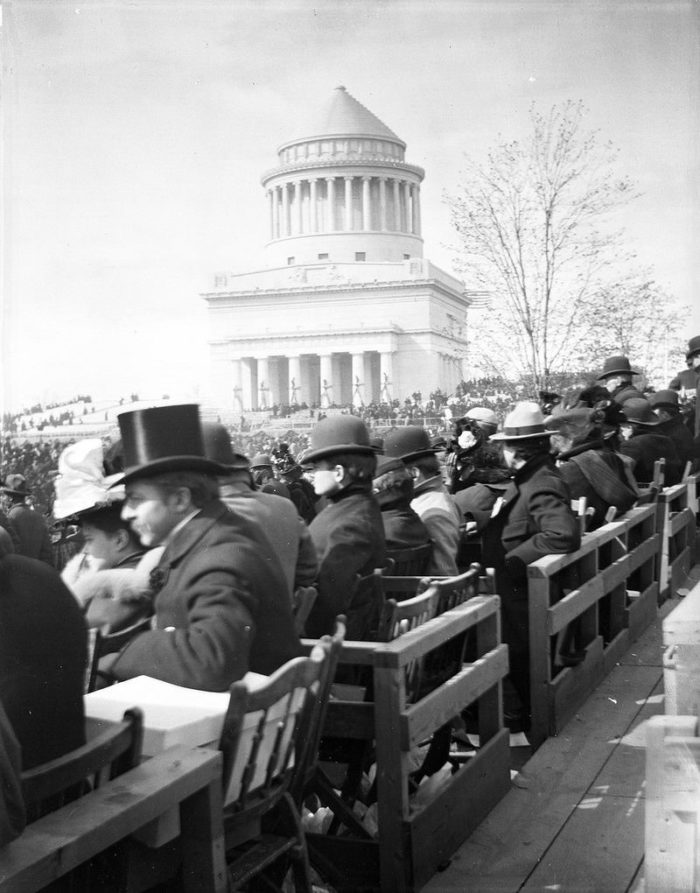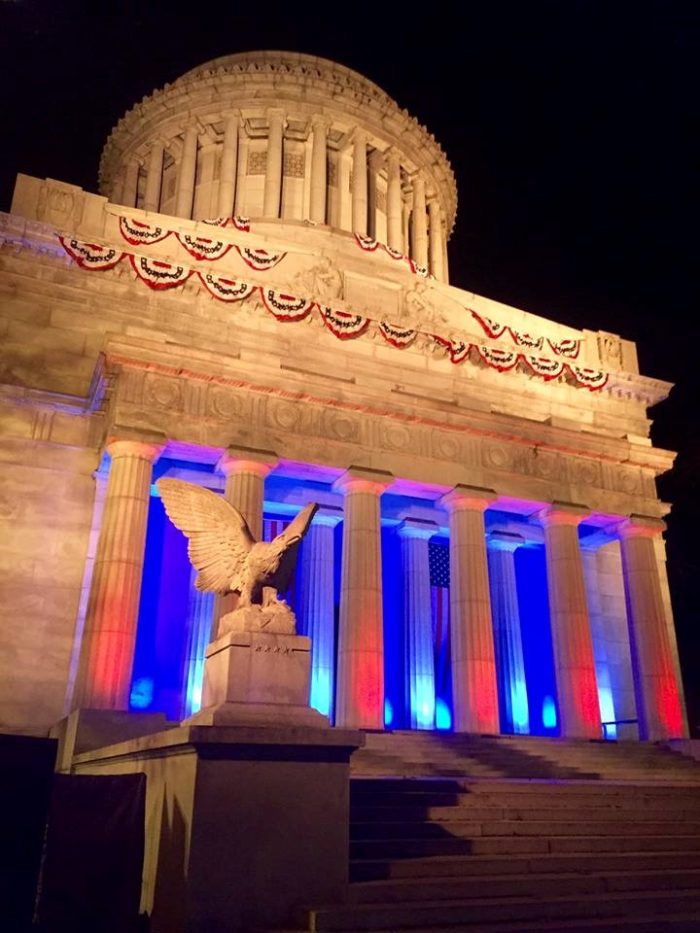The answer to “Who’s buried in Grant’s Tomb?” — a query popularized by Groucho Marx — is seemingly obvious. But let’s dig deeper and explore the historic Westside mausoleum at the center of this riddle, while we learn a bit more about our 18th president in the process.
As the popularity of Ulysses S. Grant has dimmed significantly since his death in 1885, it can be difficult for modern Americans to understand how wildly and widely admired he was during his lifetime. Perhaps now more well-known for leading the Union Army to victory in the Civil War, he was also a beloved leader. The first elected president after Abraham Lincoln’s assassination, Grant won by a landslide in each of his two presidential bids. But, while his personal reputation remained largely untouched by dishonor, his administration has since been called one of the most corrupt in history. Biographers Frederic Paxson and Christian Bach noted, “personal scandal has not touched Grant in any plausible form, but it struck so close to him and so frequently as to necessitate the vindication of his honor by admitting his bad taste in the choice of associates.”
President Ulysses S. Grant (Image: Library of Congress)
Following his presidency, Grant and his wife Julia set off on a two-year world tour that evolved into an ad hoc goodwill mission for the United States. This excursion not only solidified his popularity at home, but made him a cherished figure on the global stage. However, the trip and bad business dealings drained Grant’s savings. Destitute and indebted to generous friends, Grant turned to writing his memoirs to earn money. Shortly after he began, he was diagnosed with throat cancer, and the illness would claim his life just days after he completed his autobiography.
Grant’s heroic war record, well-regarded presidency, world tour and well-received memoir made him one of the most popular presidents ever at the time of his death. More than a million people attended his New York City funeral, and the procession is said to have stretched 7 miles long.
Grant’s funeral procession Aug. 8, 1885 (Image: Wikimedia)
A foundation was quickly formed to collect funds for a memorial, and donations poured in from around the world, eventually totaling more than $600,000 from 90,000 contributors. While New York Mayor William R. Grace quickly offered a resting place in Riverside Park, there was pushback from the general public — who thought Washington D.C. was the more appropriate location — and from family who believed the then-far-flung park along the Hudson River was far less suitable than Grant’s beloved Central Park. The controversial location would be a bone of contention for years, and while the Grant Monument Association was quickly formed, it would take a full 5 years and two worldwide design competitions before plans were chosen.
Heavily influenced by the Turkey’s Mausoleum at Halicarnassus and the Tropaeum Alpium in France, the granite and marble domed memorial included mosaics illustrating Grant’s Civil War victories, while inside, red granite sarcophagi, modeled after that of Napolean Bonaparte, bear the remains of Grant and his wife. Of the ambitious structure historian David Kahn wrote, “The mammoth and costly building in a very real sense symbolizes an entire generation’s feelings not just about Grant, but about the Civil War and the role every foot soldier played in it.”
Construction was delayed by a stonecutter’s strike and multiple design changes as the project began to outpace the available funds, and wasn’t dedicated until April 27, 1897 — 12 years after Grant’s death and the 75th anniversary of his birth. Despite the delays, more than one million celebrants attended the dedication, and the subsequent parade, led by President William McKinley, drew nearly as many as Grant’s funeral had 12 years before.
Grant’s Tomb dedication April 27, 1897 (Image: Wikimedia)
By the 1930s, the memorial’s upkeep and restoration was being overseen by the New Deal’s Work Projects Administration. During this period, stained glass was replaced, and busts of Civil War generals and two eagle statues from the demolished City Hall Post Office were added.
In 1958, the site, renamed the General Grant National Memorial, was given over to the National Park Service, who, without a clear plan for its oversight, moved forward with alternate periods of misguided alterations and abject neglect. Important documents stored within the mausoleum where lost and intentionally destroyed, murals were painted over, trophy cases destroyed and abstract mosaic art — not at all in-tune with the monument’s classical design — were added to the site. By the late 1970s, the monument became notorious for rampant graffiti, drug use and vagrancy.
In fact, it wasn’t until the efforts of a tenacious Columbia University student, that the grand structure was rescued and revitalized. While attending nearby Columbia, Frank Scaturro acted as a part-time tour guide at the site and lodged repeated complaints about its derelict state with the NPS. After the complaints fell on deaf ears for more than two years, Scaturro waged an all-out crusade to rectify the deplorable conditions by contacting the president, Congress, the media and even Grant’s descendants. Scaturro re-formed the GMA which, along with representatives from Grant’s family, sued the Department of the Interior and the NPS for their poor stewardship of the monument. The all-out attack worked; the park’s operational budget was tripled, and a $1.8-million-dollar restoration was undertaken in time for the monument’s centennial in 1997.
During the restoration, the interior murals were restored, trophy cases designed to mirror those that had been destroyed were installed, extensive graffiti removal and façade repair was undertaken and the cracked front plaza tiles were replaced.
The memorial lit for the Riverside Park Conservancy’s 2016 30th anniversary spring gala (Image: General Grant Memorial on Facebook)
One hundred and twenty years, and 27 presidents, later, Ulysses S. Grant remains the only president interred in New York City. Today, his memorial is open to visitors year-round and is the frequent site of galas and summer concerts.
And the answer to “Who’s buried in Grant’s tomb?” is: no one. As the sarcophagi are situated above-ground, there is no body “buried” in Grant’s tomb.






